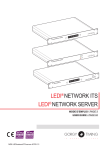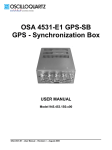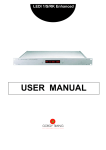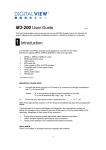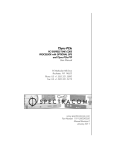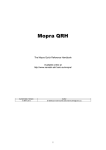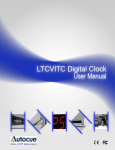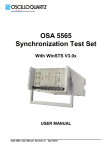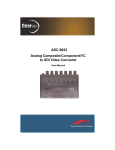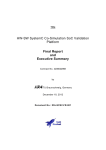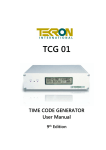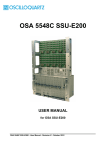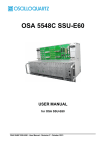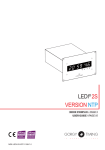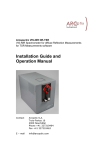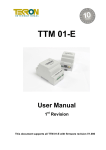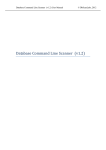Download OSA5225 rev-g16
Transcript
OSA 5225 GPS NTP Server USER MANUAL Model 945.522.5xx OSA-5225 User Manual Revision G October 2011 This page has been intentionally left blank OSA-5225 User Manual Revision G October 2011 ii What's new in this revision v Add SNMP management console installation section 7.3 v Add Oscilloquartz MIB identifier section 7.1 OSA-5225 User Manual Revision G October 2011 iii This page has been intentionally left blank OSA-5225 User Manual Revision G October 2011 iv Contents Table of Contents 1. 2. 3. 4. Page INTRODUCTION .................................................................................................................1-1 1.1 About this Manual ..................................................................................................1-3 1.1.1 Copyright Notice .........................................................................................1-3 1.2 Reading Guide ........................................................................................................1-4 1.3 Safety Instructions .................................................................................................1-5 1.4 Warranty..................................................................................................................1-8 1.5 Certification ............................................................................................................1-9 PRODUCT OVERVIEW ..................................................................................................... 2-11 2.1 Introduction ..........................................................................................................2-13 2.2 Dimensions ........................................................................................................... 2-14 2.3 Front Panel............................................................................................................ 2-15 2.3.1 Display & Switches ................................................................................... 2-15 2.4 Rear Panel ............................................................................................................. 2-15 2.4.1 Redundant 17-72VDC Connector ............................................................. 2-16 2.4.2 230 VAC Connector ........................................................................... 2-16 2.4.3 Stamp Contents ........................................................................................ 2-16 2.4.4 Alarm Connector ....................................................................................... 2-17 2.4.5 IRIG B DCLS/Sine Wave/ PPS Output ...................................................... 2-18 2.4.6 ASCII Output............................................................................................. 2-18 2.5 OSA 5225 Configuration ...................................................................................... 2-19 QUICK START ....................................................................................................................3-1 3.1 Quick Installation....................................................................................................3-3 3.1.1 Check the Package Content ....................................................................... 3-3 3.1.2 Connection .................................................................................................3-4 3.2 Configuration ..........................................................................................................3-5 3.2.1 Output Card Configuration .......................................................................... 3-5 3.3 Basics......................................................................................................................3-6 3.3.1 The NTP protocol........................................................................................3-6 3.3.2 Synchronization Concepts .......................................................................... 3-7 3.3.3 Optional OSA NTP Software ....................................................................... 3-9 3.3.4 The OSA 5225 Time Base ........................................................................ 3-12 FULL SET-UP ..................................................................................................................... 4-1 4.1 Network Configuration ...........................................................................................4-3 4.1.1 Default Configuration ..................................................................................4-3 4.1.2 Changing Network Parameters ................................................................... 4-3 4.1.3 Network Integration .....................................................................................4-4 4.2 Output Cards Configuration ..................................................................................4-5 4.2.1 Introduction .................................................................................................4-5 OSA-5225 User Manual Revision G October 2011 v Contents 4.2.2 4.2.3 4.2.4 4.3 5. 6. 7. 8. 9. Default Configuration ..................................................................................4-5 Changing the Settings.................................................................................4-6 NTP Server Output Card Configuration ....................................................... 4-6 Output Code Format...............................................................................................4-7 4.3.1 RS232, RS485, RS422 Cards ..................................................................... 4-7 4.3.2 AFNOR/IRIG-B NFS87500 ......................................................................... 4-8 4.3.3 DCF and TDF Time Code Description....................................................... 4-10 FRONT DISPLAY INTERFACE ...........................................................................................5-1 5.1 Overview .................................................................................................................5-3 5.2 Start-up Conditions ................................................................................................5-3 5.3 Time Display ...........................................................................................................5-4 5.4 Minor Alarms Conditions .......................................................................................5-5 5.5 Major Alarm Conditions .........................................................................................5-5 WEB INTERFACE ...............................................................................................................6-1 6.1 Presentation............................................................................................................6-3 6.2 Description of the WEB Interface .......................................................................... 6-4 6.2.1 Main Screen ...............................................................................................6-4 6.2.2 Standard Setup ...........................................................................................6-5 6.2.3 State Setup .................................................................................................6-7 6.2.4 NTP Setup ..................................................................................................6-7 6.2.5 Input Setup ............................................................................................... 6-10 6.2.6 Output and Display Setup ......................................................................... 6-13 SNMP ..................................................................................................................................7-1 7.1 SNMP Overview ......................................................................................................7-3 7.1.1 General Description ....................................................................................7-3 7.2 Software Information MIB ......................................................................................7-4 7.3 SNMP Management Console .................................................................................7-8 7.3.1 Configuration ..............................................................................................7-8 7.3.2 SNMP Trap Verification ............................................................................ 7-12 SPECIFICATIONS ...............................................................................................................8-1 8.1 Input Specifications ...............................................................................................8-3 8.2 Oscillator Stability ..................................................................................................8-3 8.3 Outputs ...................................................................................................................8-4 8.4 Remote Functions ..................................................................................................8-5 8.5 NTP Characteristics ...............................................................................................8-5 8.6 General Specifications ...........................................................................................8-6 MAINTENANCE & TROUBLESHOOTING .......................................................................... 9-1 9.1 OSA-5225 Output Card Switches Verification ........................................................................ 9-4 vi User Manual Revision G October 2011 Contents 9.1.1 9.1.2 9.1.3 Address Switches .......................................................................................9-4 Output Signal Format Modification for Pulses & IRIG-B DCLS Cards ......... 9-5 Input Signal Format Modification for Pulses & IRIG-B DCLS Cards ............ 9-6 9.2 Troubleshooting .....................................................................................................9-7 9.3 Oscilloquartz Contact Information ........................................................................ 9-9 9.3.1 Technical Assistance ..................................................................................9-9 9.3.2 Sales ..........................................................................................................9-9 APPENDIX A : ORDERING INFORMATION .............................................................................. A-1 DOCUMENT HISTORY .................................................................................................................... I OSA-5225 User Manual Revision G October 2011 vii List of Figures List of Figures Page Figure 2-1 Rack Dimensions ...................................................................................................... 2-14 Figure 2-2 Front Panel ............................................................................................................... 2-15 Figure 2-3 Rear Panel Connectors............................................................................................. 2-15 Figure 2-4 Redundant 17-72VDC connector .............................................................................. 2-16 Figure 2-5 230 VAC Connector .................................................................................................. 2-16 Figure 2-6 Alarm Connector ....................................................................................................... 2-17 Figure 2-7 IRIG-B DCLS Connectors ......................................................................................... 2-18 Figure 3-1 NTP Protocol .............................................................................................................. 3-6 Figure 3-2 Clock Correction ......................................................................................................... 3-7 Figure 3-3 Network Dialog ........................................................................................................... 3-8 Figure 3-4 NTP Client Software States ........................................................................................ 3-9 Figure 3-5 NTP Server States .................................................................................................... 3-10 Figure 3-6 Time Base Clock Adjustment .................................................................................... 3-12 Figure 4-1 IRIG-B Frame Format ................................................................................................. 4-8 Figure 4-2 BIT Encoding .............................................................................................................. 4-9 Figure 4-3 DCF/TDF Time Code ................................................................................................ 4-10 Figure 5-1 Front Display............................................................................................................... 5-3 Figure 6-1 WEB Interface Access ................................................................................................ 6-3 Figure 6-2 Input Date Settings ................................................................................................... 6-10 Figure 6-3 Local Time on Input .................................................................................................. 6-11 Figure 6-4 Autonomy ................................................................................................................. 6-12 Figure 6-5 Security Threshold .................................................................................................... 6-12 Figure 6-6 Output Configuration ................................................................................................. 6-14 Figure 6-7 AFNOR / IRIG-B Fine Configuration ......................................................................... 6-15 Figure 7-1 SNMP MIB example.................................................................................................... 7-7 OSA-5225 User Manual Revision G October 2011 viii List of Tables List of Tables Page Table 2-1 OSA 5225 Configuration ............................................................................................ 2-19 Table 4-1 Output Card Types ....................................................................................................... 4-5 Table 4-2 ASCII Frame Fields ...................................................................................................... 4-7 Table 6-1 Set-up Parameters ....................................................................................................... 6-9 Table 8-1 Input Specifications ...................................................................................................... 8-3 Table 8-2 Oscillator Stability ........................................................................................................ 8-3 Table 8-3 Output Specifications ................................................................................................... 8-4 Table 8-4 Monitoring Specifications ............................................................................................. 8-5 Table 8-5 NTP Characteristics ..................................................................................................... 8-5 Table 8-6 General Specifications ................................................................................................. 8-6 Table 9-1 Output Switch Addresses ............................................................................................. 9-4 Table 9-2 Output Signal Format ................................................................................................... 9-5 Table 9-3 Input Signal Format ...................................................................................................... 9-6 OSA-5225 User Manual Revision G October 2011 ix List of Procedures List of Procedures Page Procedure 3-1 Quick Install Connection ....................................................................................... 3-4 Procedure 4-1 Changing Network Parameter............................................................................... 4-3 Procedure 7-1 Firmware Version Verification ............................................................................... 7-6 Procedure 7-2 SNMP Management Config. ............................................................................... 7-11 Procedure 7-3 SNMP Trap Verification. ..................................................................................... 7-13 OSA-5225 User Manual Revision G October 2011 x Introduction Chapter 1. Introduction Including : v About this Manual v Reading Guide v Safety v Warranty v Certification OSA-5225 User Manual Revision G October 2011 1-1 Introduction This page has been intentionally left blank OSA-5225 User Manual Revision G October 2011 1-2 Introduction 1.1 About this Manual This manual has been designed to provide basic and detailed information for the correct use and operation of the OSA 5225. It summarizes the overall equipment concept and theory of operation, describes the hardware itself and provides information related to installation, operation and maintenance. It is intended for the use of the following types of users: 1.1.1 Systems Engineers: An overview of the equipment concept and theory of operation. Installation Engineers: Detailed technical information and procedures for correct installation, operation, configuration and commissioning as well as equipment specifications and maintenance guidelines. Maintenance Engineers: Information on troubleshooting, maintenance and equipment technical data. Copyright Notice Copyright © 2011 Oscilloquartz SA All Rights Reserved The Oscilloquartz product described in this book is furnished under a license agreement and may be used only in accordance with the terms of the agreement. The contents and information in this document are provided in connection with Oscilloquartz products. No license, expressed or implied by estoppels or otherwise, to any intellectual property rights is granted by this document. Except as provided in Oscilloquartz SA’s Terms and Conditions of Sale for such products. This document is exclusive property of Oscilloquartz SA and may not, in whole or in part, be copied, photocopied, reproduced, modified, translated, reduced to any electronic medium or machine-readable, stored in a retrieval system, or transmitted in any form without prior consent in writing from Oscilloquartz SA, Brévards 16, 2002 Neuchâtel 2, Switzerland. Every effort has been made to ensure the accuracy of this guide. However, Oscilloquartz SA makes no warranties with respect to this documentation and disclaims any implied warranties of merchantability and fitness for a particular purpose. Oscilloquartz SA shall not be liable for any errors or for incidental or consequential damages in connection with the furnishing, performance, or use of this manual or the examples herein. Oscilloquartz SA may make changes to specifications and product descriptions at any time, without notice. OSA-5225 User Manual Revision G October 2011 1-3 Introduction 1.2 Reading Guide Special icons, attracting your attention, precede important and/or critical information in this document. Hereafter are explanations of each icon. CAUTION This symbol is extremely important and must not be neglected. It precedes information or procedures regarding installation, operation or maintenance. Follow all steps or procedures, as instructed, to avoid any damage to equipment or serious personal injury. ELECTRICAL SHOCK HARZARD This warning symbol is extremely important and must not be neglected. It indicates that there are dangerous high voltages present inside the enclosure of this product and precedes important warnings to avoid any risk of fire or electrical shock that could lead to serious personal injury or loss of life. ESD CAUTION Electrostatic Discharge (ESD) must be avoided so as not to damage or destroy static sensitive components. Note: A note symbol informs the reader that additional information on the related subject is provided in order to simplify a described task, suggest other references or even just simplify an explanation. Recommendation: Recommendations advise the user on manufacturer tested methods and procedures proven valuable for correct use and optimum equipment results. OSA-5225 User Manual Revision G October 2011 1-4 Introduction 1.3 Safety Instructions IMPORTANT SAFETY INSTRUCTIONS. DO NOT DISCARD, READ BEFORE OPERATING GENERAL Exercise extreme care when handling any electronics equipment as it contains precision parts that can be damaged by improper handling. Avoid touching connector pin surfaces. Foreign matter deposited on contact surfaces can cause corrosion, and eventually lead to degradation of performance. In addition, do not use abrasives to clean contact/pin surfaces. FIRE For continued protection against risk of fire, ensure that only the specified fuse type and rating are used. Fuse specifications are contained in this previous section, and the label on the unit’s front panel. ESD CAUTION Electrostatic Discharge (ESD) must be avoided so as not to damage or destroy static sensitive components in the OSA 5225. Please observe proper ESD handling procedures. Use an approved anti-static bracelet in accordance with company practice. WATER AND MOISTURE Do not place containers with liquids such as coffee, water, sodas, etc. on this unit. Do not operate this equipment in a wet environment. HEATING Do not install this product near heat sources such as radiators, air ducts, areas subject to direct, intense sunlight, or other products that produce heat. OSA-5225 User Manual Revision G October 2011 1-5 Introduction GROUNDING EARTH CONNECTION IS ESSENTIAL BEFORE CONNECTING TO THE SUPPLY. The OSA 5225 shelf must be connected to Earth Ground (common bounding network (DC-C)). The wire used for the connection must be a minimum of AWG16. Ensure that all other devices connected to the 5225, are connected to protective (earth ground). (Grounding one conductor of a two-conductor outlet is not sufficient.) Any interruption of the protective (grounding) conductor (inside the equipment) or disconnecting the protective earth terminal is likely to make this equipment dangerous. Intentional interruption is prohibited. POWER Make sure the power sources are compatible with the power inputs of the equipment. Verify that the correct fuses are installed. The equipment's protective earth terminals must be connected to the protective conductor of the (mains) power cord or the station earth. The mains plug shall only be inserted in a socket outlet provided with a protective earth contact. The protective action must not be negated by the use of an extension cord (power cable) without a protective conductor (grounding). Make sure that only fuses with the required rated current and of the specified type (normal blow, time delay, etc.) are used for replacement. The use of repaired fuses and the short-circuiting of fuse holders must be avoided. Whenever it is likely that the protection offered by fuses has been impaired, the equipment must be made inoperative and be secured against any unintended operation OSA-5225 User Manual Revision G October 2011 1-6 Introduction POWER CORD PROTECTION The power supply cord for this product should be routed or installed in such a manner to protect it from being walked on or pinched. The unit should be powered down completely before connecting or disconnecting the power cable. The power cord should be removed before moving the unit. The power cord must be placed near an easily accessible unobstructed socket outlet. CLEANING Connected and running equipment can only be dusted using a soft dry cloth. ONLY WITH, AUTHORIZED PERMISSION, OUT OF SERVICE & UNPLUGGED equipment can be cleaned with a soft cloth slightly moistened with a mild detergent solution. Do not use liquid cleaners, aerosols, abrasive pads, scouring powders or solvents, such as benzine or alcohol. Ensure the surface cleaned is fully dry before reconnecting power. SERVICING AND MODIFICATIONS To avoid dangerous electric shock, do not perform any servicing or modifications other than what is recommended in this User Manual. Do not attempt to gain access to areas of the unit where dangerous voltages are present. Refer servicing to qualified service personnel. DAMAGE REQUIRING SERVICE • Refer servicing to qualified service personnel under the following conditions: • When the power supply cord is damaged. • If liquid has been spilled into the enclosure of the unit. • If the product does not function normally by following the instructions in the User’s Manual. Adjust only those controls that are covered by the operating instructions. Improper adjustment of other controls may result in damage and will often require rework by a qualified technician to restore the product to its normal operation. • If the product has been damaged in any way. When the unit displays a negative, distinct change in performance. OSA-5225 User Manual Revision G October 2011 1-7 Introduction 1.4 Warranty This Oscilloquartz product carries a warranty which commences from date of dispatch from factory. Unless agreed otherwise or stipulated differently on the original acknowledgement of order, the duration of the warranty is twenty four months. It applies to demonstrably faulty material or poor workmanship, but excludes batteries. Oscilloquartz shall bear only the cost of repair or replacement in its own premises. Should this not be possible for reasons beyond our control, all additional costs are at customer expense. Repairs under warranty carry either the balance of the original warranty or a six months warranty, whichever is longer. Damages resulting from natural wear, improper maintenance, failure to observe the operating instructions, excessive strain, unsuited consumption material as well as improper environmental and mounting conditions are excluded from this warranty. The warranty expires if the customer or a third party modifies or repairs the product without Oscilloquartz's prior written consent or if the customer does not take immediate steps to prevent the damage from becoming more serious; likewise, if insufficient time is provided for repair or replacement. The customer will not be entitled to other warranty claims. Oscilloquartz is not liable for consequential damage. OSA-5225 User Manual Revision G October 2011 1-8 Introduction 1.5 Certification EQUIPMENT CERTIFICATION: Oscilloquartz equipment is tested according to well-defined procedures. Appropriate testing and inspection takes place at the component, board, equipment and system levels. The company maintains in-house cesium standards that are continuously compared to UTC. Before any equipment is released, it must satisfy the relevant tests and inspection schedules. The equipment is then issued with a "Certificate of Conformity" that guarantees its conformance with the relevant performance criteria. The OSA 5225 Server is designed to be compliant to: • EMC EN 55022: 2007 (class B) EN 55024: 1999 + A1 2002 + A2: 2003 • SAFETY EN 60950-1: 2007 • ROHS Compliant A variety of Oscilloquartz products are certified world-wide. For details, please refer to our web site at www.oscilloquartz.com COMPANY CERTIFICATION: • Certified since 1998 by the Swiss Accreditation Service and Swiss Federal Office of Metrology as an accredited laboratory for time and frequency. • Certified ISO 9001 since 1994 and ISO 14001 since 2000 by The Swiss Association for Quality and Management Systems (SQS) OSA-5225 User Manual Revision G October 2011 1-9 Introduction This page has been intentionally left blank OSA-5225 User Manual Revision G October 2011 1-10 Product Overview Chapter 2. Product Overview Including : v Introduction v Dimensions v Front Panel v Rear Panel v OSA 5225 Configuration OSA-5225 User Manual Revision G October 2011 2-11 Product Overview This page has been intentionally left blank OSA-5225 User Manual Revision G October 2011 2-12 Product Overview 2.1 Introduction This document is a user’s guide for the OSA 5225 Time Node. The OSA 5225 is an accurate time center, easily configurable with its outputs and dual synchronization input (such as GPS, NTP, IRIG B AC, IRIG B DC) and dual power supply (230/115VAC and 20-60VDC). The purpose of the OSA 5225 is to synchronize one or several product using a synchronization signal, such as IRIG B DC, IRIG B AC, NTP, DCF or configurable Pulse (PPS, PPM…), RS232, RS422, RS485. Using the OSA 5225 provides several advantages: • The installed network architecture can be used with the well-known protocols Ethernet+TCP/IP • Simplified set-up • Easy remote configuration and diagnostics • The unit is a 19” 1U rack that can be easily installed • It provides up to 12 configurable outputs • 4 configurable and independent outputs per card Note: Jump directly to section Quick Start page for quick installation. OSA-5225 User Manual Revision G October 2011 2-13 Product Overview 2.2 Dimensions The rack is a standard 19” 1U rack. 424 mm 1U = 44 mm 482 mm 263 mm Figure 2-1 Rack Dimensions OSA-5225 User Manual Revision G October 2011 2-14 Product Overview 2.3 Front Panel 2.3.1 Display & Switches Reset Display Switch Display Figure 2-2 Front Panel 2.4 Rear Panel This section contains a description of the different connectors of the OSA 5225. All the plugs are located on the backside of the product. Ground Ethernet GPS antenna (SMA connector, with TNC Adapter) 230 VAC 18-72 VDC Optional outputs (NTP/IRIG-B/RS232/PPS) 10 MHz output Factory default Dry contact output - Power and Sync. Alarm Second synchronization input 1 PPS output Figure 2-3 Rear Panel Connectors OSA-5225 User Manual Revision G October 2011 2-15 Product Overview 2.4.1 Redundant 17-72VDC Connector + - Figure 2-4 Redundant 17-72VDC connector 2.4.2 230 VAC Connector N L PE Figure 2-5 230 VAC Connector 2.4.3 Stamp Contents The stamp that identifies the product is localized on the backside or on the top of the product. It contains the following information : OSA-5225 • Company Name: OSCILLOQUARTZ • Equipment Reference: OSA 5225 • Ordering number: A0xxxxx • Serial Number: nnnnnn User Manual Revision G October 2011 2-16 Product Overview 2.4.4 Alarm Connector Pins 3 & 4 Power alarm (without polarity) Pins 1 & 2 Synchronization alarm (without polarity) Figure 2-6 Alarm Connector Alarm conditions: PWR: Power Alarm: Pin 3 and 4 SYNC: Synchronization alarm: Pin 1 and 2 Power Alarm condition: The alarms configuration is monitoring by HTTP - NEVER, 220VAC failure, VDC failure, running on battery. Input Alarm condition: The alarms configuration is monitoring by HTTP - NEVER, IN1 or IN2 failure, IN1 and IN2 failure OSA-5225 User Manual Revision G October 2011 2-17 Product Overview 2.4.5 IRIG B DCLS/Sine Wave/ PPS Output Output 1 Output 2 Output 3 Output 4 Figure 2-7 IRIG-B DCLS Connectors 2.4.6 ASCII Output 4 outputs on DB9 connector: 1 2 3 4 5 6 7 8 9 OSA-5225 User Manual RS232 TX4 GND TX1 GND GND TX3 TX2 GND N.C. Revision G RS485 / RS422 TX4TX1+ TX1TX4+ TX3+ TX3TX2TX2+ N.C. October 2011 2-18 Product Overview 2.5 OSA 5225 Configuration FIRST INPUT CLOCK REFERENCE GPS receiver – (antenna + cable not provided) None SECOND INPUT CLOCK REFERENCE IRIG B/AFNOR NFS 87500 – 1000Hz IIRIG B/AFNOR NFS 87500 DCLS NTP None POWER SUPPLY 20-60 VDC and 230 VAC/50-60Hz 20-60 VDC and 115 VAC/50-60Hz OPTION GPS ANTENNA None OUTPUT EXTENSION (3 maximum + U) NTP/SNTP 4 outputs AFNOR NFS 87500/IRIGB 1000HZ 4 outputs PPS,PPM, PPH, PP2S, DCF (TTL, differential TTL, Phototransistor) 4 outputs DCLS (TTL, differential TTL, Phototransistor) 4 outputs Serial ASCII RS 232 4 outputs Serial ASCII RS 422, RS485 SMPTE Table 2-1 OSA 5225 Configuration OSA-5225 User Manual Revision G October 2011 2-19 Product Overview This page has been intentionally left blank OSA-5225 User Manual Revision G October 2011 2-20 Quick Start Chapter 3. Quick Start Including : v Quick Installation v Configuration v Basics OSA-5225 User Manual Revision G October 2011 3-1 Quick Start This page has been intentionally left blank OSA-5225 User Manual Revision G October 2011 3-2 Quick Start 3.1 Quick Installation This part contains the minimum information for the set-up of the OSA 5225. 3.1.1 Check the Package Content The package must contain the following items: • The unit itself: a 19” 1U rack. The name of this product is OSA 5225 GPS NTP Server which is written on the front side of the rack. • A power supply cable • SMA to TNC adaptor • A network cable • A CDROM that contains set-up and management tools. Recommendation: Contact our local representative or the Oscilloquartz Customer Support Service if one of the items above isn’t in the package. OSA-5225 User Manual Revision G October 2011 3-3 Quick Start 3.1.2 Connection Recommendation: It is highly recommended that to know the serial number (written on identification stamp), the localization and a short description for the unit. STEP ACTION 1 Connect the synchronization outputs to the equipment (see the Rear Panel section for more information). Connect the ground stud to a suitable ground building. 2 Connect the OSA 5225 to the network using the network cable. 3 Connect the OSA 5225 to a power supply using the power supply cable when it is present. The system should work immediately if there is a DHCP server on the network. Procedure 3-1 Quick Install Connection Recommendation: Fill-in the physical localization for each unit. This is possible using the TimeNetMng tool localized on the CD-ROM. For more information, see the Changing Network Parameters section. OSA-5225 User Manual Revision G October 2011 3-4 Quick Start 3.2 Configuration OSA 5225 is configured in factory to automatically get an IP address. Two mechanisms are used: • If a DHCP server is present on the network, the OSA 5225 gets an address automatically. This ensures that the IP address is compatible with the network • If no DHCP server is present, the OSA 5225 automatically takes an IP address using the AutoIP mechanism. In this case, the address is in the range 169.254.x.y (where x and y are in the 0..255 range). If both server and client have started in this mode, they should work correctly together but their IP addresses may be incompatible with other products on the network. 1 If no DHCP server is present, or manual network configuration is preferred, use the TimeNetMng tool on the CDROM to change the network parameter. Please refer to part Changing Network Parameters for more information. Recommendation: Don’t hesitate to contact the network administrator for the configuration of the OSA 5225. He can help in optimizing the network installation. 3.2.1 Output Card Configuration The default configuration for all the output cards is to deliver UTC time. The time received from the NTP server is directly sent to the output. Each card can be configured to output several local times. This configuration is done through a WEB browser (see the Output Cards Configuration section). 1 For example, if it is not possible to configure the OSA 5225/DCLS from a WEB navigator. OSA-5225 User Manual Revision G October 2011 3-5 Quick Start 3.3 Basics This part contains a description of the basic concepts of the OSA 5225. It helps to understand the behavior of the unit under various circumstances. The OSA 5225 contains a NTP server. It can contain an NTP client software designed for good-level precision and security. This NTP software is tightly coupled to a SNMP agent that allows high-level management and supervision of the OSA 5225. 3.3.1 The NTP protocol NTP (Network Time Protocol) is a network protocol that allows the time synchronization of different equipments through a TCP/IP+Ethernet network. The communication is based on a client/server dialog. The OSA 5225 acts as the server and all the equipment to be synchronized act as clients. Each time, a client needs to be synchronized, it asks the time to the server. The client application should integrate several computations to compensate the transmission delays over the network. Depending on the client software, a precision close to some milliseconds can be expected. The OSA 5225 with the NTP client option guarantees accuracy better than the ms. Request time TCP/IP+Ethernet network Return time NTP client Figure 3-1 NTP Protocol OSA-5225 User Manual Revision G October 2011 3-6 Quick Start The time information exchanged through the network is the UTC Time (GMT+0). A client (for example a PC) must convert this time using its own time-zone information (and eventually by applying day saving correction). The NTP protocol has reserves for security by implementing an encryption system: each exchanged frame can be encrypted using the protocols DES and MD5. In addition to the OSA NTP client software for Windows, you can found several NTP client programs for a variety of hardware on the site: www.ntp.org/software 3.3.2 Synchronization Concepts 3.3.2.1 Clock Correction Principles The objective of the synchronization is to make two clocks indicating the same time. In the case of NTP based synchronization, the NTP client clock must indicate the same time than the NTP server clock. To perform this synchronization, the NTP client software permanently compares the two clocks and computes the following information: • Offset: It’s the difference between the time of the server clock and the time of the client clock. For example, if the server clock indicates 2:10:13 and the client clock indicates 2:11:14, the offset is –1:01; • Drift: It’s the frequency difference between the two clocks. When drift is not null and without clock correction, the offset between the two clock increase or decrease depending on the drift sign. 2 The following figure shows how the evolution of the two clocks with or without drift: server time Drift is null : server time client time client time Evolution during time server time server time Drift is constant : client time client time Figure 3-2 Clock Correction 2 There are several reasons for the presence of a drift between two clocks: generally the drift is due to the temperature difference between the two clocks. 3-7 OSA-5225 User Manual Revision G October 2011 Quick Start The objective of the synchronization of a NTP client to a NTP server is to reduce as much as possible the drift and the offset. The accuracy and stability of the client clock is tightly coupled to the efficiency of the reduction process. 3.3.2.2 Network Dialog The real drift and offset of the OSA 5225 clock related to the NTP server are estimated from a measured offset. This offset is computed by subtracting the client clock date from the server clock date. Periodically, the client estimate current offset from the server. This measure is done using a message-passing mechanism as shown on following figure: client side Network server side Query server date Return current server date Receive reply date Figure 3-3 Network Dialog On a LAN, it takes some milliseconds between the time when the client asks for the date and the time when it receives the reply. This time is due to transmission delay on the network. It can vary because of network load or NTP server load. Worse, the transmission time from client to server is generally not the same that the one from the server to client. Actually, on a large period of time, the difference of sum of client-server and serverclient transmission delays is zero. The NTP client algorithm implemented in the OSA 5225 is designed to compensate transmission delay and to average the measures. 3.3.2.3 Working with Several Servers The NTP client software has the ability to work with several NTP servers (up to 3 servers). When not enough reply is received from a server or this server doesn’t reply or reply too slowly, the NTP client software uses another one. OSA-5225 User Manual Revision G October 2011 3-8 Quick Start 3.3.3 Optional OSA NTP Software To use the OSA 5225 to synchronize a PC, Windows Time must first be set in manual or disabled mode to prevent Windows NTP Server to load in priority (this tool is located in the services tools). This is to be done with the Network Administrator's permission. 3.3.3.1 NTP Client Software States Here are the different states of the NTP client software: Searching servers Starting Learning environment Auto-detection Learning environment Learning Enable outputs No reply Tracking Commuting Commutation OK Figure 3-4 NTP Client Software States Here is a description of these states: OSA-5225 • Starting: The software is starting, it initializes and check the hardware if needed. • Auto-detection: Server auto-detection is activated. The NTP client tries to find OSA servers. At least one detected server is required to leave this state. • Learning: The NTP client software has found one or several servers (auto-detection activated) or works with configured servers. In this state, the software learns network properties. About 2 minutes are required to complete this stage. User Manual Revision G October 2011 3-9 Quick Start • Tracking: Normal behavior, the NTP client permanently evaluate its offset and drift with the server. • Commuting: Not enough reply received from current server, trying another server. 3.3.3.2 The NTP Server States The following figure shows the different states of the NTP server: Run autonomously Idle Startup Locked Rescaling Failure Rescaled/Tracking Autonomous Figure 3-5 NTP Server States OSA-5225 User Manual Revision G October 2011 3-10 Quick Start Here is a short description of the different states: OSA-5225 • Idle Just after the power-on. • Startup The NTP software is waiting for hardware information. It doesn’t reply to NTP clients requests. • Rescaling The NTP software has received both the date and the PPS from the hardware. The phase difference is too important. The NTP software doesn’t reply to NTP clients requests and try to reduce the phase difference. • Rescaled/Tracking The phase difference is small enough. The NTP server is now operational. It replies to NTP clients’ requests. Moreover, it still tries to reduce the phase difference if possible (tracking mode). • Failure At any time, the NTP software can enter this state if it doesn’t receive a correct date or the PPS from the hardware and cannot guarantee a good accuracy on its internal clock. • Synchronized Means time server is lock on the PLL. The offset between client and server is very low. • Synthetized Means time server is locking on the PLL because the offset between client and server is few tenths of milliseconds. This state depends on several parameters, time since power on, synchronization time, reference server stability used, dissymmetry NTP request between go and return • Autonomous When there is no time code at the input and that the OSA 5225 can guarantee a good accuracy. • Locked When the NTP software enters this state, it doesn’t reply to clients’ requests. The software enters this state when it detects a large phase difference that will overlap the security threshold value or when the user manually locks the server. In this state, the unit continues on its own time base until the date becomes lower than the threshold value again, or until a reboot. • Run autonomously (Free Running) The NTP server runs without using the time source code. This mode is useful for test procedure when no time source is available, but the time stability is dependant of the quartz present on hardware. User Manual Revision G October 2011 3-11 Quick Start 3.3.4 The OSA 5225 Time Base The core of the time base is an high accurate OCXO. The mechanism to adjust the clock of the time base with the synchronization input depends on the time difference between the input clock and the time base clock (∆clocks) . Step (µs/s) 1000µs/s 50µs/s 0,1µs/s 0 ,02µs/ 0 1 50 ∆clocks (µs) Figure 3-6 Time Base Clock Adjustment For example whether ∆clocks is inferior to 1µs, the algorithm increase or decrease the frequency of the clock time base by 0,02µs/s step. In event of ∆clocks is superior to 1ms (1000µs), the step is 1000µs/s. OSA-5225 User Manual Revision G October 2011 3-12 Full Set-up Chapter 4. Full Set-up Including : v Network Configuration v Output Cards Configuration v Output Code Format OSA-5225 User Manual Revision G October 2011 4-1 Full Set-up This page has been intentionally left blank OSA-5225 User Manual Revision G October 2011 4-2 Full Set-up 4.1 Network Configuration 4.1.1 Default Configuration The OSA 5225 is configured to automatically take an IP address from a DHCP server. At startup, the unit broadcasts a DHCP query to get an IP address. This query contains a DHCP name. There are two cases: • If a DHCP server is installed on the network, it record the DHCP name and return an IP address. The OSA 5225 starts working with this address. • If no DHCP server is installed, the OSA 5225 automatically uses a default IP address in the range 169.254.x.y (where x and y are between 0 and 255). The default SNMP name of the unit (that can be seen from a SNMP browser or from a WEB browser) is OSA5225nnnnnn with nnnnnn, the serial number on 6 digits. 4.1.2 Changing Network Parameters Use the TimeNetMng tool provided on the CDROM to configure the unit: STEP ACTION 1 Insert the CDROM in the drive. Start the TimeNetMng tool that is localized in the "Software" directory. 2 The TimeNetMng tool displays automatically the OSA products installed on the network. Each line contains information about one connected product. 3 Double-click on the line related to the unit to be configured. 4 Set the network parameters and physical localization and click the Set! button. Procedure 4-1 Changing Network Parameter OSA-5225 User Manual Revision G October 2011 4-3 Full Set-up 4.1.3 Network Integration Network settings do not have to be changed in the following cases: • A DHCP server is present and there is enough reserved IP address for the product. • No DHCP server is present but, but access to the unit through its WEB or SNMP interface is not needed. In this case, the AutoIP mechanism will automatically affect an IP address but this address will probably be incompatible with the network. If several products work with AutoIP, they could work together. Some DHCP servers have the capacity to register the unit in the DNS. In this case, the registered name is the DHCP identifier. Then, access to the unit from the WEB or SNMP browser is possible. For example, to assign the DHCP name ntpsrv1 to the OSA 5225, simply type ntpsrv1 in the address field of the WEB browser. If there are several products to install, it is highly recommended to follow the following steps: • Note the serial number and physical localization of each product during the installation and connection. • On a PC, connected on the same network as the products, start TimeNetMng. All the OSA products should appear with their serial number. Set the network parameter and localization using the document filled at previous step. • OSA-5225 The document should be kept for further reference. User Manual Revision G October 2011 4-4 Full Set-up 4.2 Output Cards Configuration 4.2.1 Introduction The OSA 5225 is provided with up to 3 output cards in 1U. Each output card is tightly synchronized on either the NTP time code received from the NTP server or the GPS or the IRIG B input card. Each card acts as a kind of translator that receives time from the main synchronization source and output specific time code. Currently, there are 9 kinds of cards: NTP/SNTP Ó 4 outputs AFNOR NFS 87500/IRIGB 1000HZ Ó 4 outputs PPS,PPM, PPH, PP2S, DCF (TTL, differential TTL, Phototransistor) Ó 4 outputs PPS,PPM, PPH, PP2S, DCF (TTL, differential TTL, Static Relay) Ó 4 outputs DCLS (TTL, differential TTL, Phototransistor) Ó 4 outputs DCLS (TTL, differential TTL, Static Relay) Ó 4 outputs Serial ASCII RS 232 Ó 4 outputs Serial ASCII RS 422, RS485 Ó SMPTE Ó Table 4-1 Output Card Types 4.2.2 Default Configuration At expedition from OSA factory, all the output cards are configured to output UTC time and time is constant all along the year (no Day Saving Time correction). The display is managed as an output card and can be configured in the same way. Important Note: The signal format on PPS cards and DCLS cards can be changed to TTL, differential TTL (RS422) or phototransistor / static relay (depending of the card type). See the Output Card Switches Verification section. OSA-5225 User Manual Revision G October 2011 4-5 Full Set-up 4.2.3 Changing the Settings Open the WEB site of the OSA 5225 (see the WEB Interface section.). Click on the button. The current configuration of the unit appears on the screen. In this screen each card can be tuned independently (see the Output and Display Setup section). After changing the settings, click on the button. The modification should appear immediately at the outputs or on the display. 4.2.4 NTP Server Output Card Configuration An NTP server output card can be added to the OSA 5225. In this way, different local networks can be synchronized on several NTP servers, synchronizing themselves on the same hardware reference. The NTP server card must be configured in the same manner as the OSA 5225. Its default network configuration is DHCP mode with identifier OSAnnnnnn with nnnnnn, the serial number on 6 digits. The default SNMP name of the NTP server (that can be seen from a SNMP browser or from a WEB browser) is OSA5225nnnnnn with nnnnnn, the serial number on 6 digits. To change the network parameters of the NTP server card, use the TimeNetMng tool (see the Changing Network Parameters section). Like the OSA 5225, the NTP server output card provides a WEB page for fine configuration (see the WEB Interface section) and a SNMP MIB for supervision through the network. OSA-5225 User Manual Revision G October 2011 4-6 Full Set-up 4.3 Output Code Format 4.3.1 RS232, RS485, RS422 Cards The default configuration is shown below: • STX D The ASCII frame is a 23 characters frame with following format: A Y D D / M M / Y Y H H : M M : S S CR Here is a description of the different fields of this frame: Field Size Value/Meaning STX 1 A single byte which value is 2 – mark the beginning of the frame. DAY 3 The day in the week in a human-readable way (MON for Monday, TUE for Tuesday, WED for Wednesday, THU for Thursday, FRI for Friday, SAT for Saturday, SUN for Sunday DD 2 Day in the month on two characters ASCII (01-31) MM 2 Month in the year on two characters ASCII (01-12) YY 2 Year on two characters ASCII (00 for 2000 – 99 for 2099) HH 2 Hours on two characters ASCII (00 to 23) MM 2 Minutes on two characters ASCII (00 to 59) SS 2 Seconds on two characters ASCII (00 to 59) CR 1 A single byte which value is 13 decimal – marks the end of the frame Table 4-2 ASCII Frame Fields OSA-5225 User Manual Revision G October 2011 4-7 Full Set-up 4.3.2 AFNOR/IRIG-B NFS87500 4.3.2.1 Frame Format Figure 4-1 IRIG-B Frame Format OSA-5225 User Manual Revision G October 2011 4-8 Full Set-up 4.3.2.2 Bit Encoding The signal is modulated only on ‘B’ card. The ‘T’ card output signal has TTL level. Figure 4-2 BIT Encoding OSA-5225 User Manual Revision G October 2011 4-9 Full Set-up 4.3.3 DCF and TDF Time Code Description Details of message transmitted over a full minute : "0" synchronization bits year 8 4 10 20 40 80 P3 M control bits 0 2 1 10 8 month 4 2 1 4 day of week 2 (1= monday ; 7= sunday) 1 20 10 8 10 50 J+1 =JF JF ES E/H HE HH "0" "1" 20 40 4 day of month 1 2 1 P2 20 2 30 10 8 40 20 4 2 1 P1 10 8 4 minutes hours KEY: J JF ES E/H HE HH P1, P2, P3 Current day State holiday Standby transmitter used Indicates a seasonal changeover on the next hour Summer time Winter time Parity bits Figure 4-3 DCF/TDF Time Code OSA-5225 User Manual Revision G October 2011 4-10 Front Display Interface Chapter 5. Front Display Interface Including : v Overview v Start-up Conditions v Time Display v Minor Alarms Conditions v Major Alarm Conditions OSA-5225 User Manual Revision G October 2011 5-1 Front Display Interface This page has been intentionally left blank OSA-5225 User Manual Revision G October 2011 5-2 Front Display Interface 5.1 Overview The front display interface can display up to 16 characters. Two buttons provide display configuration and global reset. The OSA 5225 uses the front display to show current time and different alarm conditions. Switch display mode accuracy/satellites Reset the unit Figure 5-1 Front Display 5.2 Start-up Conditions During start-up, the time and date of the OSA 5225 are not valid and are not displayed. The following texts appear: OSA-5225 • When the device is started, all the dots on the display are lit. • During hardware initialization, the following text is displayed: • Then, the IP address of the product appears. • If there is no time code at the input, the OSA 5225 displays the following message: User Manual Revision G October 2011 5-3 Front Display Interface 5.3 Time Display When no alarm is present and time code is present at the input of the OSA 5225, the current time of the server is permanently displayed. • When display is configured to show UTC time, the following information is alternatively displayed: IN1 FRI IN1 07 OCT. • Using the mode button, displays either the accuracy or the number of GPS satellites 07 satellites OR > 20us > 1 us OCXO WARM UP OCXO LOCK OSA-5225 User Manual Revision G October 2011 5-4 Front Display Interface 5.4 Minor Alarms Conditions There are two possible minor alarms. These alarms are displayed alternatively with the date: • When there is no time code at the input and the OSA 5225 can guarantee enough accuracy on its internal clock, the following text is displayed: • When the time difference is too important, the OSA 5225 tries to rescale its clock and display Rescaling. 5.5 Major Alarm Conditions • OSA-5225 Without time code and when the OSA 5225 can’t guarantee accuracy, it stops delivering time on outputs or NTP and displays the following text: User Manual Revision G October 2011 5-5 Front Display Interface This page has been intentionally left blank OSA-5225 User Manual Revision G October 2011 5-6 WEB Interface Chapter 6. WEB Interface Including : v Presentation v Description of the WEB Interface OSA-5225 User Manual Revision G October 2011 6-1 WEB Interface This page has been intentionally left blank OSA-5225 User Manual Revision G October 2011 6-2 WEB Interface 6.1 Presentation The OSA 5225 can be configured and supervised through a WEB interface. This interface provides the following features: • Management of network parameters; • Management of SNMP parameters; • Management and diagnostic of server software itself; • Management and diagnostic of output cards. Each OSA 5225 has its own WEB server that delivers WEB pages. To access the WEB site, type-in the address of the OSA 5225 in the address field of the WEB browser (as shown below) and validate the input. 3 Figure 6-1 WEB Interface Access 3 If the OSA 5225 has been configured in DHCP mode and the server automatically registers the DHCP name in the DNS, the DHCP name can also be used instead of the IP address. 6-3 OSA-5225 User Manual Revision G October 2011 WEB Interface 6.2 Description of the WEB Interface 6.2.1 Main Screen This is the screen that appears when accessing the WEB site of the OSA 5225. The first four buttons on the left of the screen provide an access to the following panels: 1. Standard: information about the product and configuration of network parameters. See the next section. 2. State : Current working state of the product 3. SNMP: configuration of SNMP parameters; 4. NTP: diagnostic and configuration of the NTP software behavio; 5. Input: offset from input time code, autonomy and autonomous running mode configuration. 6. Output: diagnostic and configuration of output cards and display; 7. Download : Download a new software release The button updates immediately the OSA 5225 configuration. The configuration is stored permanently in an EEPROM. WARNING Some parameters cannot be modified without restarting the OSA 5225. When changing these kind of parameters and clicking on the button, the OSA 5225 restarts with the new parameters and needs some seconds before re-enable its output and generate NTP code. OSA-5225 User Manual Revision G October 2011 6-4 WEB Interface 6.2.2 Standard Setup When clicking the Standard button, the network parameters and unit information are displayed. In the top of the panel, the network parameters and the WEB access password can be controlled. In the bottom of the panel, information about the unit is displayed. 6.2.2.1 Network Parameters WARNING When clicking on the button after changing one or several network parameter(s), the OSA 5225 must restart to use the network parameters. During the reset and a few seconds after, the outputs and the NTP output are deactivated. Here are the different parameters: 4 • IP mode Indicate if the OSA 5225 works with a fixed IP (set in the field IP address) or use DHCP protocol (the DHCP identifier is set in the field DHCP identifier). • IP address Indicate the network address affected to the unit. An IP address is made of four numbers separated by a dot. Each number range from 0 to 255. • DHCP identifier Identifier to be used when the OSA 5225 is configured in DHCP mode. This identifier has 8 letters maximum. • Network submask Indicates the width of the network used. For example, a network submask 255.255.255.0 indicates that only the last number change (in the example above, address in the network can change between 192.168.10.1 to 192.168.10.254) 4. • Gateway address If the OSA 5225 needs to communicate with products outside the local network, a gateway must be indicated. • Without gateway Check this box if there is no gateway on the network (or if it is not used). When configuring several units to communicate on the same network, the network submask must be the same. 6-5 OSA-5225 User Manual Revision G October 2011 WEB Interface 6.2.2.2 Product Information Here is a description of the product information area: • Hardware è Serial number Displays the OSA serial number of the unit. This is a 6 digits number which is the same than the one stamped on the bottom or background of the rack. • Hardware è Product code Displays the OSA base code of the product without option. • Ethernet Interface è (MAC) Address Indicates the Medium Access address of the Ethernet interface of the OSA 5225. • Firmware è Version/Release Date Version of the software running in the OSA 5225. • Last reboot reason A text indicating why the OSA 5225 has restarted the last time. 6.2.2.3 WEB Site Access Protection To protect access to the parameters of the OSA 5225, specify a password. This is done by entering the password twice in the area Enter password and Confirm password (the same password in both areas). WARNING The name of user is user. Once a password is set, it will be required at the next connection. OSA-5225 User Manual Revision G October 2011 6-6 WEB Interface 6.2.3 State Setup The standard state of the unit is displayed : • State : Current state of the unit (Free running, tracking….) • Synchronization : Current state of the synchronization (Input 1 is waiting, Input 1 is synchronizing…) 6.2.4 NTP Setup When clicking the NTP button, the configuration of the NTP server software of the OSA 5225 is displayed. 6.2.4.1 Description Here is the short description of the different fields: • STRATUM level the stratum value to be stored in the NTP messages sends to the NTP clients. • Reference ID A 4 letters identifier that gives information about the time reference. This value is put in the appropriate field in the NTP frame When not synchronized Define the effect on some NTP fields when the OSA 5225 is not synchronized 5. The possible values are LI&STRATUM unchanged, STRATUM=0,LI unchanged, STRATUM unchanged, LI=3(11b), STRATUM=0, LI=3(11b) The OSA 5225 with NTP client option can be synchronized on up to three NTP servers. In fact, the NTP software uses only one server at the same time but can commute to another server when there is no or not enough reply. The NTP configuration panel shows what is the synchronization mode used by the server or selected by the NTP software. It also shows the servers defined by the user or detected by the software. 5 Time code is not present (server is autonomous) or the received time-code indicates that external synchronization is lost OSA-5225 User Manual Revision G October 2011 6-7 WEB Interface Different servers used for synchronization and the current synchronization mode could be change by the user. Four modes can be selected: - Auto-detection Sync one server Sync two redundant servers Sync three redundant servers Auto detection mode indicate than the OSA 5220 scan, try and use servers present on your network and use the more appropriate synchronization mode. In fact, the IP address server can be add. 6.2.4.2 OSA-5225 Synchronization mode and IP address server User Manual Revision G October 2011 6-8 WEB Interface When selecting the checkbox Auto-detection, the OSA 5225 tries to use the NTP servers present on the network and use the more appropriate synchronization mode. If not the checkbox Auto-detection is not selected, it is necessary to indicate the synchronization mode and the NTP servers to be used. The following table can help in selecting the more appropriate parameters: One server # of NTP servers used 1 Two servers 2 Three servers 3 Mode Description Use only one server for synchronization Use the first server at startup. If this server fails, commute to the second server. If this server fails, commute to the first one and so on… Use the first server at startup. If this server fails, commute to the second server. If this server fails, commute to the third one and so on… Table 6-1 Set-up Parameters OSA-5225 User Manual Revision G October 2011 6-9 WEB Interface 6.2.5 Input Setup When clicking on the Input button, the input configuration of the OSA 5225 is displayed. 6.2.5.1 Time Base Run Autonomously This box can be checked to set the OSA 5225 to run autonomously, independently of the time on input. Set the actual date like shown below and validate the date by pressing Figure 6-2 Input Date Settings NOTE This mode is useful for client-server synchronization tests, or if there is no synchronization source. However, the date is not exact, and the accuracy is not guaranteed. OSA-5225 User Manual Revision G October 2011 6-10 WEB Interface 6.2.5.2 Input 1 or Input 2 Local Time on Input In some cases, the unit is not synchronized on an UTC time source but on a local time source for example. It is then necessary to configure the time zone from the Greenwich Mean Time (GMT), and the Day Saving Time policy of the source. For example in Switzerland, the local time is UTC+1 hour in winter and UTC+2 in summer. Here is the needed configuration: Offset from UTC : +1h00 DST : European Union When using UTC time source, keep the “Local time on input” checkbox unchecked. Figure 6-3 Local Time on Input Manual / Automatic Transmission Delay Compensation The transmission delay compensation can be used to compensate the IRIG-B cable length or GPS repeater for example. Set the value in microsecond if the delay is known. In automatic mode, the transmission delay of an input is calculated with its constant phase from the driving input. If the driving input is in automatic, its compensation delay will be null, as it is the reference for the unit. OSA-5225 User Manual Revision G October 2011 6-11 WEB Interface Autonomy Figure 6-4 Autonomy If the time source is lost, the unit can work in autonomous mode. When the autonomy time end is reached, the unit stops providing time on its outputs or NTP time. The autonomous duration can be chosen or set to infinite duration. Security Threshold Gives the maximum phase difference (in seconds) allowed on the time source before locking the NTP server software. This field is initialized to “inactivated”. Figure 6-5 Security Threshold OSA-5225 User Manual Revision G October 2011 6-12 WEB Interface Leap Second Policy and NTP Frame LI Indicator If a leap second occurs at the 1st of January or the 1st of July of the current year, the unit can be programmed to insert a leap indicator (LI) in its NTP frames or DCF frames (when a DCF output card is present). This indicator will be active one day in advance for NTP, and one hour in advance for DCF, and will be automatically reset on the 1st of January or the 1st of July. Note that the unit will proceed to a leap second only when the jump is received from the external synchronization source. Available values : no additional second last minute as 61 seconds last minute as 59 seconds 6.2.6 Output and Display Setup When clicking on the Output button, the configuration of the output of the OSA 5225 is displayed. This panel shows a synthetic view of the outputs of the unit. The display is considered as an output and is driven by a display card. An OSA 5225 can contain up to 3 output cards (4 for the DCLS) plus the display card. The display and each output of each output card can be configured INDEPENDENTLY. When an output card is not present or in failure, its box doesn’t appear. At this time, there are 9 kinds of output cards: NTP/SNTP 4 outputs AFNOR NFS 87500/IRIGB 1000HZ 4 outputs PPS,PPM, PPH, PP2S, DCF (TTL, differential TTL, Phototransistor) 4 outputs PPS,PPM, PPH, PP2S, DCF (TTL, differential TTL, Static Relay) 4 outputs DCLS (TTL, differential TTL, Phototransistor) 4 outputs DCLS (TTL, differential TTL, Static Relay) 4 outputs Serial ASCII RS 232 4 outputs Serial ASCII RS 422, RS485 SMPTE OSA-5225 User Manual Revision G October 2011 Ó Ó Ó Ó Ó Ó Ó Ó Ó 6-13 WEB Interface 6.2.6.1 Standard Output Configuration Description and hardware version of the card. Disables the output Daylight Saving Time Policy Offset to apply to UTC time Figure 6-6 Output Configuration The previous picture shows the configuration panel for an AFNOR/IRIG-B. In addition, the description contains identification and version of the program embedded in the output card (there, it’s the program NTP4DCL1, version 0539). Each output card can be configured independently through the following parameters : • Output Deactivation Except the display, all the output cards can be deactivated. The deactivation has the following effects : o o o • For ASCII+TOP card, the time frame is not generated and the TOP outputs are in the open state; For AFNOR output, the carrier is not modulated. The ALARM output doesn’t generate warning signal. Time Zone The “Time Zone” is a time offset that can be added or subtracted from the time received through the NTP protocol (which is UTC time) to generate local time. For example in Switzerland, local time is GMT + 1:00. OSA-5225 User Manual Revision G October 2011 6-14 WEB Interface • Day Saving Time In addition to the Time Zone, many countries apply a Day Saving Time correction. The year is made of two areas: in summer time, 1 hour more is added to the time (after Time Zone correction), in winter time only the Time zone correction is applied. Don’t forget to select the appropriate country in the WEB interface. Here are the different DST policies : European Union Start: Last Sunday in March at 1 am UTC End: Last Sunday in October at 1 am UTC USA / Canada / Mexico / St. Johns / Bahamas / Turks / Caicos Start: First Sunday in April End: Last Sunday in October Start: Last Sunday in October End: Last Sunday in March Start: Last Sunday in March at 2 am local time End: Last Sunday in October at 2 am local time Australia – Standard Russia 6.2.6.2 Fine Output Configuration Some output cards provide specific configuration : ASCII + PPS Fine Configuration : The period and the width of the pulse can be configured. For example DCF top, PPS , PPM. AFNOR / IRIG-B Fine Configuration : Choose the frame format : Afnor, IRIG-B or IRIG-B + binary second. Figure 6-7 AFNOR / IRIG-B Fine Configuration OSA-5225 User Manual Revision G October 2011 6-15 WEB Interface SMPTE CONFIGURATION : The SMPTE output code format can be configured here. The user bit field ban be customized or automatically filled with the date. The time of the SMPTE code can be rescaled every second on the device time base, or at a specific time of the day. OSA-5225 User Manual Revision G October 2011 6-16 SNMP Chapter 7. SNMP Including : v SNMP Overview v Software Information MIB v SNMP Management Console OSA-5225 User Manual Revision G October 2011 7-1 SNMP This page has been intentionally left blank OSA-5225 User Manual Revision G October 2011 7-2 SNMP 7.1 SNMP Overview 7.1.1 General Description The very standardized SNMP protocol provides a means to get information and alarms from the OSA 5225. Alarms are sent to a SNMP browser localized on a computer identified by its IP address. Up to 8 IP Trap address can be specified that allows the alarm monitoring from 8 different computers. The SNMP screen settings allow configuring the main elements of such alerts : • IP address(es) for sending alerts (traps) • Product Name (for information) • System location (for information) • System contact (for information) The generated alerts (traps) and the MIB are in v2c format. Much of the current MIB activity occurs in the portion of the ISO branch defined by object identifier 1.3.6.1 and dedicated to the Internet community. Under this community, there is the private branch, which contains the Enterprises branch in which, private companies can define their own MIB’s. Oscilloquartz is officially identified under this branch with the number 5551. The following tree shows where Oscilloquartz is identified within the Management Information Tree. 1 = OSI 1.3 = ISO Identified, organisation 1.3.6 = US DOD 1.3.6.1 = Internet 1.3.6.1.4 = Private 1.3.6.1.4.1 = Enterprises 1.3.6.1.4.1.5551 = Oscilloquartz OSA-5225 User Manual Revision G October 2011 7-3 SNMP 7.2 Software Information MIB The necessary MIB files are located in the SNMP folder at the root of this CD-ROM. Please read the "MIB_information.txt" file which provides important information for choosing the correct MIB file in association to the OSA 5225's firmware. The OSA 5225 firmware version is noted in the unit's FAT (Factory Acceptance Test) which is delivered with the unit. The firmware version can also be verified using web access connection as described in the following procedure. STEP OSA-5225 ACTION 1 Power On the 522x and connect RJ45 cable on the connector. 2 Use Time Network Manager to detect 522x IP address 3 Open a web access and insert the IP address and press enter. User Manual Revision G October 2011 7-4 SNMP STEP 4 OSA-5225 ACTION If necessary enter: user or password User Manual Revision G October 2011 7-5 SNMP STEP 5 ACTION Click on the Standard Menu Procedure 7-1 Firmware Version Verification OSA-5225 User Manual Revision G October 2011 7-6 SNMP The following print screen is an example of one of the recent MIB versions. Figure 7-1 SNMP MIB example OSA-5225 User Manual Revision G October 2011 7-7 SNMP 7.3 SNMP Management Console This section provides examples of management console equipment integration using the "Castle Rock" program and an OSA 5201 unit. 7.3.1 Configuration STEP ACTION 1 Launch the SNMP SERVER software 2 Insert the computer IP address 3 Copy the MIB file provided on this CD-ROM to the PC. In this example: C:\Program Files\SNMPc Network Manager\mibfiles OSA-5225 4 Add the OSA 5225 using: Insert -> Map Object -> Device 5 Introduce the equipment IP address, the label and other parameters if necessary. User Manual Revision G October 2011 7-8 SNMP STEP 6 ACTION Change the access properties. Insert -> Map Object -> Device 7 OSA-5225 Value public: Read/Write community Install MIB file Select: Config -> MIB database User Manual Revision G October 2011 7-9 SNMP STEP 8 OSA-5225 ACTION Configure the SNMP server for trap SNMP reception and/or other. Four addresses can be defined for this program. Select Tools -> Mib Browser User Manual Revision G October 2011 7-10 SNMP STEP ACTION 9 Select trapDestTable enter IP address and click on Set 10 The server or other computer will receive the SNMP trap. The next section describes how check the completed configuration. Procedure 7-2 SNMP Management Config. OSA-5225 User Manual Revision G October 2011 7-11 SNMP 7.3.2 SNMP Trap Verification To validate communication between the server SNMP and the equipment, two possibilities are describe below 7.3.2.1 First method STEP 1 OSA-5225 ACTION Select Tools Poll Obect… User Manual Revision G October 2011 7-12 SNMP 7.3.2.2 Second method STEP 1 ACTION Generate an event on the equipment, for example remove the GNSS cable Procedure 7-3 SNMP Trap Verification. OSA-5225 User Manual Revision G October 2011 7-13 SNMP This page has been intentionally left blank OSA-5225 User Manual Revision G October 2011 7-1 Specifications Chapter 8. Specifications Including : v Input Specifications v Oscillator Stability v Outputs v Remote Functions v General Specifications OSA-5225 User Manual Revision G October 2011 8-1 Specifications This page has been intentionally left blank OSA-5225 User Manual Revision G October 2011 8-2 Specifications 8.1 Input Specifications GPS Antenna INPUT Input Connectors Type Specifications SMA with TNC adaptor • Frequency: 1575.42MHz • Impedance: 50 Ohms • Acquisition sensitivity -130dBm Table 8-1 Input Specifications 8.2 Oscillator Stability OSCILLATOR Model Holdover Stability (at 25°C) Stability Versus Temperature (-0°C to 60°C) Accuracy Ageing after 30 days of continuous operation In-service adjustments Life time -10 5e10 -8 1e10 -9 <10 -10 2e10 /day None required > 15 years Table 8-2 Oscillator Stability OSA-5225 User Manual Revision G October 2011 8-3 Specifications 8.3 Outputs STANDARD OUTPUTS 10 MHz Specifications • • • • Level: -1.5dBm to 7dBm @ 50ohms Impedance: 50Ω Connector: BNC Rear panel location 1 PPS Level: 1.7Vpp ± 20% @ 50ohms Rise time and fall time <10ns Puls Width: 1ms • Impedance: 50Ω • Connector: BNC • Rear panel location Specifications • SNMP, HTTP Specification • Connector: RJ-45 • Number: Network type: Accuracy: Connector: 1 Ethernet 10/100 Base-T +/- 20 µs Typical RJ-45 Numbers: Type: Protocole: Level: Accuracy: Connector: 4 IRIG-B AFNOR NFS 87500 2.2Vpp to 8,8Vpp 20 µs (1000Hz) 8 pins OPTIONAL OUTPUTS NTP Specifications • • • IRIG-B / AFNOR NFS Specifications • • • • • • IRIG-B / DCLS Specifications • • • • • Numbers 4 Type: TTL, differential TTL, or configurable pulse (PPS, DCF…) Rise time: 10ns, accuracy: 100ns Accuracy: 500 µs Connector: 8 pins ASCII (RS422/RS485) Specifications • • • • Numbers Type: Accuracy: Connector: 4 RS422, RS485, unidirectional 500 µs DB9 Numbers Type: Accuracy: Connector: 4 RS232 unidirectional 500 µs DB9 ASCII (RS232) Specifications • • • • Table 8-3 Output Specifications OSA-5225 User Manual Revision G October 2011 8-4 Specifications 8.4 Remote Functions MONITORING AND ALARMS HTTP (RFC 2616), RJ45 TELNET (RFC 854 to 861), RJ45 SNMP + MIB II (RFC 1213), RJ45 DHCP (RFC 2131), RJ45 UDP / TCP Time protocol (RFC 868), RJ45 IPv4 and IPv6* *Contact Oscilloquartz for availability. Two static relay alarms (Power supply and synchronization) Management Alarms TM 128 bits RSA MD5 encryption HTTPS with management of up to 8 REALMS* SSL V3 and TSL V1 and certificate mgmt* IPSec* *Contact Oscilloquartz for availability. Electrical Outputs Table 8-4 Monitoring Specifications 8.5 NTP Characteristics REQUESTS RPS • • Examples of ∆t for different NTP clients • • • • Up to 800 RPS per NTP port without MD5 enabled Up to 400 RPS per NTP port with MD5 enabled Windows 2000 ∆t : 28800s up to 23 million clients Windows XP ∆t : 3600 to 604000s 2 to 480 million clients Windows 2003 ∆t : 900s up to 700'000 clients Common NTP/SNTP client soft : 60s max up to 48000 clients Table 8-5 NTP Characteristics Note: RPS : Number of requests per second ∆t : Number of seconds between two requests per second sent by the NTP/SNTP client Number of clients = RPS x ∆t OSA-5225 User Manual Revision G October 2011 8-5 Specifications 8.6 General Specifications DC POWER SUPPLIES Configuration Input Voltage Power Consumption AC POWER SUPPLY Input Voltage Power Consumption Electrical Autonomy Environmental Environment Operating Temperature Storage Temperature Humidity CE & RoHs EMC Safety RoHs MECHANICAL Mounting Size h x w x d mm (in.) Weight Connector Access Fully redundant power supply "inputs" 20 to 60 VDC Warm-up : ~ 40W Steady state : ~ 38W 230 VAC or 115VAC max. : 0.5A 50-60Hz typ. : 20mA plus 2mA per output Warm-up : ~ 40W Steady state : ~ 38W Typical 2 hours on internal NiMH battery, 5 to 7 years lifetime. Storage: as specified in ETS 300 019-1-1, class 1.1 Transportation: as specified in ETS 300 019-1-2, class 2.2 Operation: as specified in ETS 300 019-1-3, class 3.2 Vibration : as specified In ETS 300 019-2-1, -2, & -3. +0° to +50°C (+32° to 122°F) -40° to +70°C (-40° to 151°F) 5 to 95% non condensing. EN 55022 class B EN 55024 EN60950-1 Compliant to 2002/95/EC of 27/01/03 19" rack mount. 19" 1U: 44mm (1.73’’) x 482mm (19’’) x 263mm (10.35’’) ~ 2.3 kg (5 lbs) excluding packing. Rear access. Table 8-6 General Specifications OSA-5225 User Manual Revision G October 2011 8-6 Maintenance & Troubleshooting Chapter 9. Maintenance & Troubleshooting Including : v Output Card Switches Verification v Troubleshooting v Oscilloquartz Contact Information OSA-5225 User Manual Revision G October 2011 9-1 Maintenance & Troubleshooting This page has been intentionally left blank OSA-5225 User Manual Revision G October 2011 9-2 Maintenance & Troubleshooting This section provides information about preventive maintenance ESD CAUTION To avoid electrostatic discharge (ESD) damage to components in the OSA 5225, observe the appropriate electrostatic discharge (ESD) precautions and procedures. CAUTION To avoid damage, under no circumstances should the interior of the unit be allowed to come in contact with water. To avoid electromagnetic discharge and damage to the circuitry, never attempt to clean the unit with a vacuum. Note: If you encounter problems during any of the following procedures, contact our Customer Services. Keep the unit’s original packaging for re-shipping the product. If the original packaging has been discarded, contact the Customer Services Department for assistance. OSA-5225 User Manual Revision G October 2011 9-3 Maintenance & Troubleshooting 9.1 Output Card Switches Verification 9.1.1 Address Switches To add an output card or if an output seems to be in failure (does not appear in the WEB page), open the device and verify the switch configuration on the output cards: Output 1 Output 2 (the nearest of Output 3 Output 4 (the furthest of the supply card) the supply card) 1 output 1 2 3 4 5 6 7 8 1 2 3 4 5 6 7 8 1 2 3 4 5 6 7 8 1 2 3 4 5 6 7 8 1 2 3 4 5 6 7 8 1 2 3 4 5 6 7 8 1 2 3 4 5 6 7 8 1 2 3 4 5 6 7 8 1 2 3 4 5 6 7 8 2 outputs 3 outputs 4 outputs 1 2 3 4 5 6 7 8 Table 9-1 Output Switch Addresses CAUTION The 8th switch of each card allows testing the card by forcing the signal on output. It MUST be turned OFF again after testing. OSA-5225 User Manual Revision G October 2011 9-4 Maintenance & Troubleshooting 9.1.2 Output Signal Format Modification for Pulses & IRIG-B DCLS Cards The Pulses and AFNOR NFS87500/IRIG-B DCLS outputs cards can provide several formats : • TTL • Differential TTL (RS422) • Phototransistors or static relays, depending on the card type. OFF ON SW1 Output 4 SW2 SW3 SW1 Output 3 SW2 SW3 . . . Signal format For each output SW2 SW1 SW1 Phototransistor or static relay RS422 / differential TTL TTL ON (Right) ON (Right) ON (Right) ON (Right) OFF (Left) OFF (Left) OFF (Left) OFF (Left) OFF (Left) Table 9-2 Output Signal Format OSA-5225 User Manual Revision G October 2011 9-5 Maintenance & Troubleshooting 9.1.3 Input Signal Format Modification for Pulses & IRIG-B DCLS Cards The OSA 5225 (with the AFNOR NFS87500/IRIG-B option) can accept several kinds of AFNOR NFS87500/IRIG-B input signals depending on the configuration of the main board switches. 9.1.3.1 OSA 5225 Main Board Switches Motherboard : Input 2 – Time code 1 AFNOR DCLS AFNOR SINE WAVE IEEE1344 DCLS IEEE1344 SINE WAVE IRIG-B DCLS IRIG-B SINE WAVE NTP None 2 3 Input option card present ON ON X X OFF OFF ON ON OFF OFF ON ON OFF ON OFF ON OFF ON YES YES YES YES YES YES X X X X OFF ON NO NO AFNOR / IRIG-B input option card Switchs DCLS – TTL DCLS – RS422 Sine wave (differential TTL) OFF ON SW1 SW2 1 ON (Right) OFF (Left) OFF (Left) 2 ON (Right) ON (Right) OFF (Left) SW4 3 ON (Right) ON (Right) OFF (Left) SW5 4 ON (Right) ON (Right) OFF (Left) SW6 5 ON (Right) OFF (Left) OFF (Left) SW7 6 – load ON / OFF 7 – inversion ON / OFF OFF (Left) Left/Right OFF (Left) Left/Right Left/Right OFF (Left) SW3 Table 9-3 Input Signal Format OSA-5225 User Manual Revision G October 2011 9-6 Maintenance & Troubleshooting 9.2 Troubleshooting This section tries to answer the most frequent questions concerning the use of the OSA 5225 NTP unit. First, ensure that the TimeNetManager software is installed on the computer. I made a « Scan now ! » with TimeNetManager but I cannot see the unit ? 1. Verify the cable connection. If Ethernet LEDs are visible, the upper-left LED should be green. Otherwise, there should be a network connection or power supply failure. 2. If using several VLAN (Virtual Local Area Network), verify that the unit is on the same VLAN as the computer. 3. Connect the computer directly to the unit using a cross cable. In DHCP mode, the unit automatically takes an address in the range 169.254.x.y if it does not find a DHCP server. Change the computer IP address in this range, with a network mask of 255.255.0.0. I cannot open the configuration WEB page ? 1. First, is the unit reachable with TimeNetManager? è YES The computer and the unit should have the same IP range and the same network mask. è NO See previous question. 2. Has the page been found by the browser (the loading begins but fails after a while) ? è NO, PAGE NOT FOUND If using “Internet Explorer”, go to : Tools à Internet Options à Connections à Network Parameters The browser should not use a proxy; uncheck all checkboxes. OSA-5225 User Manual Revision G October 2011 9-7 Maintenance & Troubleshooting è YES WEB page is reachable, but the browser is unable to load it. Open a TELNET session: Telnet < ip address> 9999 Password : gtmt Proceed to a “Factory Default”, then “Quit and save”. Refresh the WEB page. An output is not visible in the configuration WEB page ? 1. Press ‘F5’ to refresh the WEB page, and go back to output panel. If the output is still missing, see next point. 2. Open a TELNET session: Telnet < ip address> 9999 Password : gtmt Proceed to a “Factory Default”, then “Quit and save”. Refresh the WEB page. 3. If the output is still missing, open the unit. Check the black cables connections and the switches configurations (see Output Card Switches Verification). The screen displays “no time code!” or “NO TIME CODE!” ? 1. “NO TIME CODE!” : verify the time source because the unit is not synchronised. 2. “no time code!” with the date : if the unit receives a time code, verify in the input panel of the configuration WEB page that “run autonomous” is not checked. Recommendation: Contact a local representative, or the Oscilloquartz Customer Support Service for any service inquiries and advice on Timing issues and inquiries. OSA-5225 User Manual Revision G October 2011 9-8 Maintenance & Troubleshooting 9.3 Oscilloquartz Contact Information 9.3.1 Technical Assistance For technical assistance, contact the following: 9.3.1.1 International Oscilloquartz SA Customer Support & Services 16, Rue de Brévards 2002 Neuchâtel 2 SWITZERLAND Tel: +41-32-722-5555 Fax: +41-32-722-5578 e-mail: [email protected] 9.3.2 Sales For sales assistance, contact the following: 9.3.2.1 International Oscilloquartz SA Sales & Marketing 16, Rue de Brévards 2002 Neuchâtel 2 SWITZERLAND Tel: +41-32-722-5555 Fax: +41-32-722-5556 e-mail: [email protected] OSA-5225 User Manual Revision G October 2011 9-9 Maintenance & Troubleshooting This page has been intentionally left blank OSA-5225 User Manual Revision G October 2011 9-10 Ordering Information Appendix A: Ordering Information The OSA 5225 is not field configurable. Internal Cards are fixed and cannot be interchanged when the shelf is installed on a rack. There are no internal field-replaceable components. The shelves are constructed to a fixed order and shipped for field installation. Therefore, only accessories can be ordered as spare or replaceable parts. Please contact Oscilloquartz for configurations and ordering. OSA-5225 User Manual Revision G October 2011 A-1 Ordering Information This page has been intentionally left blank OSA-5225 User Manual Revision G October 2011 A-2 Document History Document History Project N° Document Type Version Author Revision Last Up-date Creation : : : : : : : 5225 User Manual English OSA G 10.10.2011 28.04.2008 REVISION A B DATE 28.04.2008 18.06.2008 06.11.2008 C D E 23.02.2009 27.04.2009 26.05.2009 F 09.08.2010 G 10.10.2011 OSA-5225 User Manual Revision G CORRECTIONS - Creation based on previous 5220/5225 manual - Change type of cable for PC-unit connection - Add chapter for SNMP - Up-date photos and drawings - Change OSA USA office address - Correct minor typographical errors and page set-up - Up-date operating temperature range - Up-date rear panel photo and connections - Add ASCII connector pin description - Change Telnet IP address in troubleshooting section - Up-date SNMP chapter - Add "Firmware version verification" procedure - Up-date MIB file association information - Add SNMP configuration - Add NTP server states - Add NTP setup - Add NTP characteristics (specs) - Add SNMP management console installation - Add Oscilloquartz MIB identifier October 2011 I












































































































